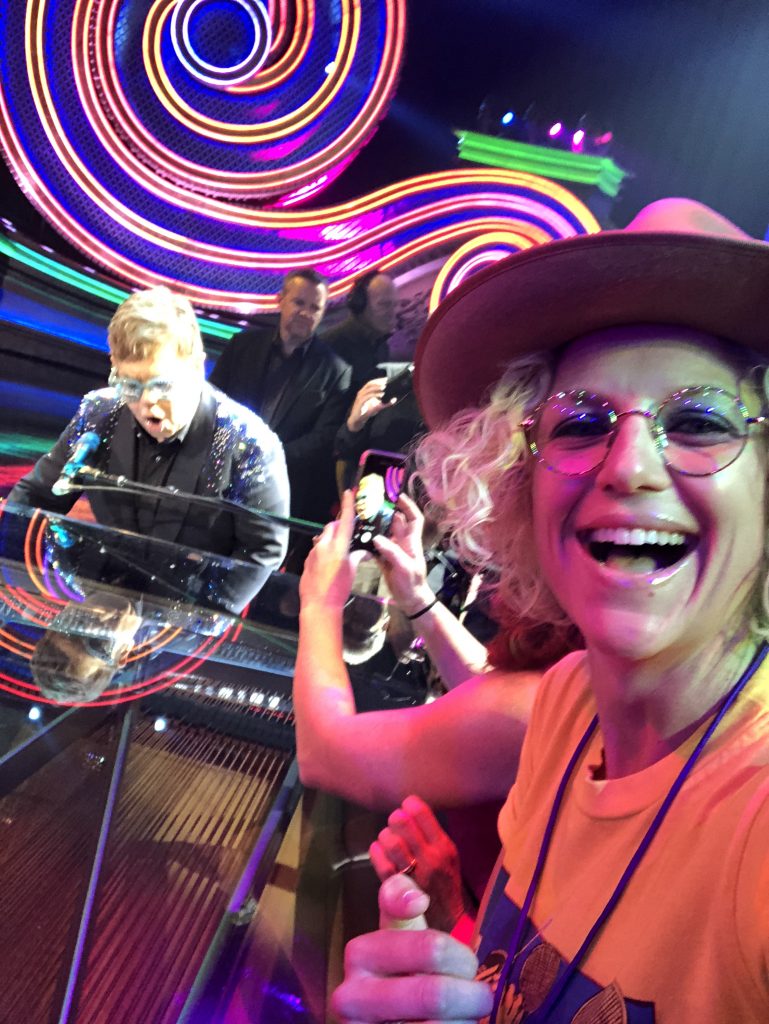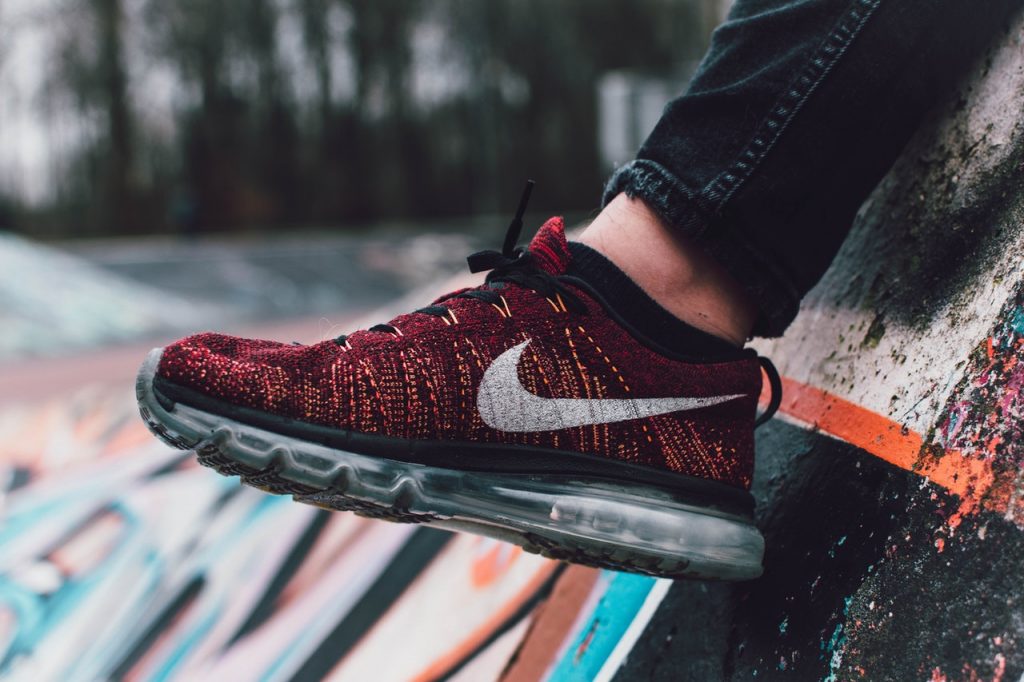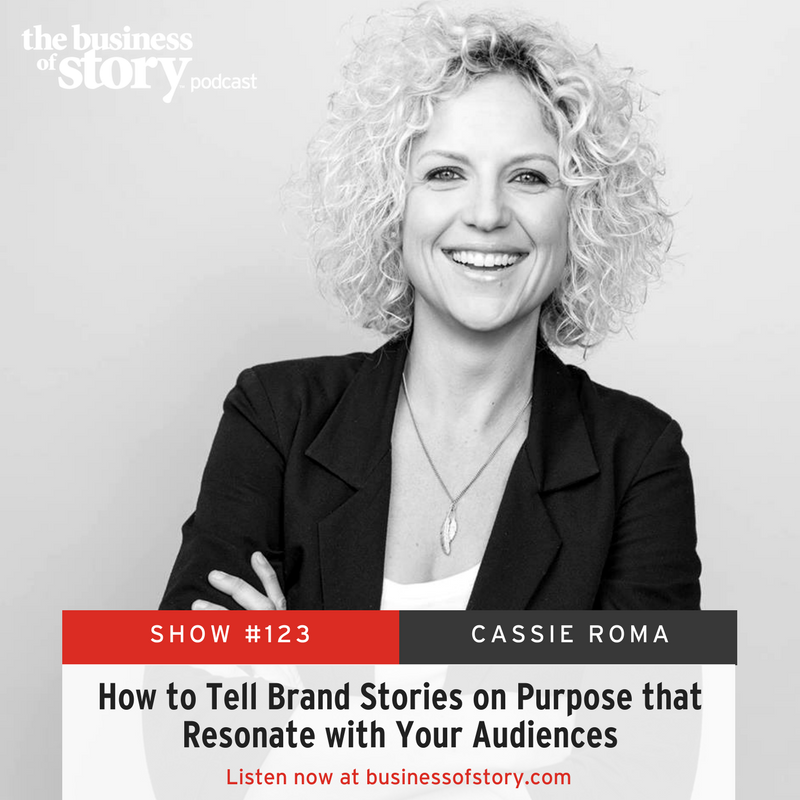This time last week I was on stage with Elton John.
On. The. Freakin’. Stage.
To put the excitement I felt then, & still feel now, into context: I’ve seen Sir Elton 21 times in 21 years. He’s my musical Boo & has written most of the soundtrack to my youth & adulthood.
When all of my classmates were rocking out to Nirvana, No Doubt, & Weezer – I was locked in my room playing EJ’s LPs & voraciously consuming whimsical words penned by Bernie Taupin. (Yes, I was THAT kid. And, if we’re honest, I still am.)
I’m still obsessed with lyrics & the poetry inherent in them. I adore the cadence of written & spoken language & the different emotions expressed through nuance.
And, I am full-tilt in love with storytelling – the magic of it, the movement of it, & the power a good story has to cause people to act.
Starting my run of Rocket Man concerts at 15yrs old, I never imagined 20 others would follow, or that I’d end up standing on stage, literally leaning on the piano whilst rocking out to Saturday Night’s Alright For Fighting in front of 5,000 people.
When I posted a selfie of Elton & I to Facebook the night of my life-changing sing-along, friends & family from across decades threw heart-shaped reactions my way & recounted their own memories.
In tiny, comment-sized snippets, people showed their support & excitement for my dream-come-true moment. And then went further. They shared personal stories & dove into their own lives & experiences. Some of the memories had me in them.
When OUR Story Becomes MY Story
To my surprise though, most of the memories shared were individual, private, & deeper than your usual “here’s what I had for breakfast” comment that we tend to get on social media.
Reading through the stories my beloveds shared, I started thinking about the power of connected experiences & the impact they have on our lives – whether in a personal sense, a business sense, or a cultural one.
Stories are the most powerful tool any of us have in cultivating connections, & by rights, success. In a business sense, the importance of connecting with your audience is crucial to success at all junctures.
Today’s marketing landscape is fraught with uncertainty. It is futuristic in feel, but traditional in iteration. And, motivating customers feels like an over complicated science.
So how do we get people to connect with us? How do we inspire people to act? How do we truly demonstrate what’s at stake when it comes to choosing one brand or product or strategy over another?
Putting People First. Always.
First & foremost, let’s talk about people.
In business terms, we call them all kinds of things: customers, consumers, target audiences, top-of-the-funnel, AP12-65+. I’m a fan of simplicity & always remembering WHY we’re telling stories in the first place.
 When I think about brands that seem to get it right all of the time (though they don’t), brands like Nike, Apple, Coca-Cola or Qantas I think not of logos – but of stories & of people. It’s not the placement. Not social media, or billboards, or TVCs, or logos on smart digital retargeting ads. Those are all tactical parts of clever marketing campaigns.
When I think about brands that seem to get it right all of the time (though they don’t), brands like Nike, Apple, Coca-Cola or Qantas I think not of logos – but of stories & of people. It’s not the placement. Not social media, or billboards, or TVCs, or logos on smart digital retargeting ads. Those are all tactical parts of clever marketing campaigns.
Nope, it’s people that these storytelling masters concentrate on.
Many of us invest in & feel emotionally connected to the stories of the underdogs that win big. At the same time, we also love the stories of the underdogs that just keep pushing to be a part of the pack. They might not win big, but they try hard & we all know that the end goal is moving mountains one grain of sand at a time.
At this crucial juncture in the storytelling cycle, magic happens. This is the point where brand stories become our stories. We as consumers, not as marketers, emotionally invest in the stories we’re being told & the tell them back in our own way.
You cannot put a dollar value on people you don’t know, who are buying your stuff, helping to share your stories in their own voice. Like I said, that’s the magic of smart, measured storytelling.
Wooing Our ROI Baes, On The Daily
But how do we as brand marketers, or storytellers, or small business owners, or social media managers find a nugget of golden insight to form our story? What’s the process?
The simple & complex answer is this: we must all do our homework, gather information about our intended audience & then tickle out human truths, shared goals, & inspiration out of it all.
Humans are our commercial bread & butter at every juncture. Our ROI Baes, out there ready to be wooed. Our everything.
It’s absolutely imperative that we treat consumers & potential customers as our most valuable assets & as the hero of our stories when marketing to them.
Motivating Your Audience To Act
To get audiences to understand what’s at stake in the story cycle of your business, it’s important that you understand what you stand for. Chris Martin & Coldplay sing about going back to the start & a lot of the time where I see brands fail at storytelling is in the very simple act of not knowing, or not being able to share with others their purpose.
![]()
What is it that your business believes in? You might be selling shoes, or toilet paper, or have your own consulting business – but knowing where the business started, where it’s headed, & what it stands for is key to getting your customers & potential customers understanding, believing in, & telling back your stories.
You might stand for kindness, believe in protecting the environment, or you might simply exist to make the lives of others easier. Whatever your purpose, bring it to the forefront of your marketing.
Some great examples of brands that come to mind when I think about stories told well over time are businesses like Vans who’ve stood the test of time & from day dot have had a cool, edgy, skateboarding feel that even preppy city kids are proud to wear.
With a re-emergence of 90’s fashion lately, there hasn’t been a single day where I haven’t seen at least a dozen people in retro or new styled Vans on my way to work (I’m guilty of owning 6 pairs myself).
I’d say Vans is doing a great job of telling their story through advertising. So good in fact that their consumers tell it back en masse by wearing the brand on their feet. I’d call it a feat of the feet. In fact, it’s pretty darn amazing that a massive global shoe company still feels like underground skate brand.
Walking billboards & brand advocates indeed.
The Give & The Gain
So, let’s flip this around a bit for a moment. Let’s not talk about what brands get from people, but what people get from brands. What exactly is it that people gain through your stories as marketers or salespeople?

I’d say, when done right, a lot. Let’s take Nike for example. Nike is both about action & inspires it. Along with the human stories & sporting star ambassador brand ads for big celebrities, Nike are magicians at telling stories of the everyday athlete.
Nike celebrates regular people just as they do elite athletes.
The person who walks to work? An athlete.
The weekend trail warrior who runs 4 X a month? An athlete.
The reformed gym junkie who wants to get back in shape? An Athlete.
Everyone can be what they dream to.
Just do it. Right?
From Nike’s stories, people gain confidence. They see individuality celebrated & diversity put on a pedestal. When I lace up my Nikes I feel like the hero in the story. Nike’s simply helping me take one more step, run one more mile, jump a little bit higher than last time.
We All Judge Books By Their Covers. Don’t Be Beige.
I’d be remiss not to mention the aspect of social proof that comes along when customers adopt a brand story into their lives. The truth of it all is that we judge books by their covers. And, in turn, we judge brands by their stories.
Wearing one brand over another on your body is a signal that you believe in & want others to see that you believe in, the ethos of what that particular brand stands for.
I love my Levi’s 501 jeans, I wear them most days. They’ve kind of become my thing. My calling card as it were. A colleague of mine loves Samsung & is well known for politely talking at people for hours over lunch about why the device he loves trumps an Apple every time.
Social proof is a major positive outcome for individuals & brands alike who allow their customers to truly embrace what’s at stake emotionally with a brand.

The cool factor. It’s another thing you can’t put a dollar amount on or get without being completely genuine in how you present your brand & what you stand for. The cool factor IS NOT status quo.
Status-quo is the opposite of standing out.
And, yes, there are times when businesses want to simply keep on truckin’ with the BAU. But if you’re after growth & longevity, staying status quo won’t get you either in today’s inundated marketplaces.
Storytelling, therefore, is the perfect way to use language & media to stand out from the din of advertising & marketing noise that follows all of us everywhere we go.
The Long & Winding Road
As you can tell, I am passionate about the power of storytelling for marketers, for consumers, for humanity in general. Stories are the glue that hold the world together – literally. Without them, we’d have no shared past, present, or future.
In fact, we’d all be in a vacuum of no communication or connection. That vacuum does not sound like a fun place to live & dream & be.
In closing this article I’d like to point to how important it is to always, always, always putting your audience at the forefront of your story – not your brand. Think in human terms. In stories big or small, be clever with the words you use, read them out loud, test them. Then be consistent. Think long-term.
And, listen to your customers. Believe me, they’ll tell you how they feel – either online, or in their purchase behaviors. If you hook your customers & keep giving them reasons to connect over & over again, your business will grow. Your brand will resonate. And, you just might find that ever elusive cool factor that everyone’s chasing.
Listen to Cassie Roma on episode #123: How to Tell Brand Stories on Purpose that Resonate with Your Audiences








